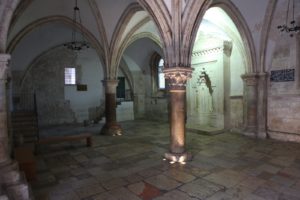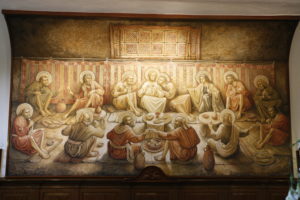As a devout Israelite, Jesus would celebrate the Jewish Passover (Pesach) every year. In his early years, he did so with his father Joseph and his mother Mary; and later, with his disciples. In Nazareth, Jesus learned from his father Joseph how to preside over the Passover rites. Additionally, during those Passovers in Nazareth, a neighboring family would likely join them, as the Passover required that the entire lamb be consumed in one celebration. They also drank four cups of red wine mixed with water: the Cup of Slavery, the Cup of Judgment, the Cup of Blessing, and the Cup of Consummation. All of this was interspersed with prayers and psalms, consuming roasted lamb, unleavened bread, and bitter herbs.
However, Jesus would celebrate the last three Passovers of his life with his disciples, and we know that the final one was celebrated with them in Jerusalem. It appears that the current Upper Room was owned by Zebedee during Jesus’ time. He used it as a dwelling when it was his turn to serve at the Temple, because the priests dedicated one week a year to their service and then engaged in other occupations, which in Zebedee’s case was fishing. It’s important to remember that the tribe of Levi did not have land to cultivate; their inheritance was to serve in the temple.
That Passover, the last with his disciples, was very special, and the apostles transmitted this to us. It began with the simple people’s praise of their Master, who entered Jerusalem riding on a donkey, while the crowd spread their cloaks, waved palms, and acclaimed him as the Messiah.
The house where they celebrated Passover was located at the top of a hill called Zion. Jesus and his disciples celebrated Passover on the upper floor, while Mary and the women who followed him were on the ground floor. The celebration began, and after the second cup, Jesus began to share very intimate things that they did not fully understand. At one point, after giving them the bread, he gave them the third cup, uttering words they had never heard him say before: “Take this, all of you, and drink from it, for this is the chalice of my Blood, the Blood of the new and eternal covenant, which will be poured out for you and for many for the forgiveness of sins.” Then, rising, he went out towards the Kidron Valley to reach the Garden of Gethsemane and pray. It was night, and the apostles were perplexed and tired, so they fell asleep despite the Master’s request that they watch and pray. They knew they had not taken the fourth cup, so the Passover celebration had not been completed.

The Cenacle in Jerusalem
That night, many things happened quickly, though for the Master, they were long and painful. Jesus was abandoned by his friends and taken to the house of Caiaphas, where, at the crowing of the rooster, his gaze met Peter’s, who had denied him three times. Then he was taken before Pontius Pilate. There he was scourged and crowned with thorns, then laden with a cross and led to a hill outside the city, where he was crucified.
Once on the cross, they offered him a mixture of myrrh and water to lessen the pain of crucifixion, but Jesus did not taste it. However, when he was about to expire, he said, “I thirst,” and being offered a sponge soaked in vinegar, he took it and drank. Then, he said, “It is finished,” and bowing his head, he handed over the spirit.
The Passover was fulfilled, and within it were encompassed all the new events that the Master wanted to engrave on the hearts of his disciples: the sacrifice of the Mass, centered on the Eucharist, and the new priesthood. Moreover, during that long Passover, he showed them their mission, not as a mere service but as that offered by slaves to their masters, washing their feet. And above all, he spoke unsettling words: “I no longer call you servants, but friends,” not calling them disciples, but friends. Friendship to share the most intimate, that which surpasses the realm of the will and enters into personal love. He invited them to share in his Trinitarian Mystery in his personal intimacy. Now they could fully understand and love what he had tried to share with them for the last three years and could not.
In response to all this abundance of grace and fullness, they unanimously fled. They were unable to accept his friendship. Similar to how they were not able to cast out the demon on that occasion when the father presented his son to the disciples. (Mt 17:19). Thus, the fragility and smallness of their knowledge, faith, and love were undeniably evident.

The Last Supper with Jesus
Over the years, how grateful Saint Peter would be for that night when he denied Jesus and He, looking into his eyes, forgave him. Likewise, Saint John clearly grasped his lack of faith, for he did not believe until he entered the tomb and then, only then, he “saw and believed” (John 20:1-19). What an extraordinary lesson so that they never placed their trust in their knowledge, nor in their “status,” but only in the Holy Spirit.
In the depths of their heart, a miracle occurred: their conversion upon encountering the true face of Jesus. Jesus was a person who, being God, accepted them as redeemed men. Since then, Jerusalem has a special feel.
By Domingo Aguilera
